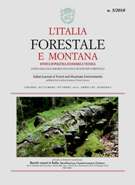Special section
OLD-GROWTH FORESTS IN ITALY: INPUTS FOR FOREST MANAGEMENT AND PLANNING IN AREAS WITH LONG-STANDING HUMAN IMPACT
Published 2013-05-16
Keywords
- virgin forests,
- old-growth forests,
- old-growthness,
- adaptive management,
- complexity
Copyright (c) 2013 Italian Journal of Forest and Mountain Environments

This work is licensed under a Creative Commons Attribution-NonCommercial 4.0 International License.
Abstract
The paper discusses if and how research results can support forest management and planning in areas where forests have been heavily and pervasively modified during thecenturies. Along with the rare tracts of old-growth forests, the reduction in forest utilization which has taken place in Italy starting from the 1960’s has favored natural development and
an increasing degree of “old-growthness” in many once managed forest stands.
Difficulties in using “old-growth” forests as models for sustainable forest management in this situation arise from many factors: scarcity and limited surface of most old-growth
forests; relatively short history of non-management; heavily disturbed surrounding matrix.
Further uncertainty is added by the fact that old-growth forests have developed in climatic and environmental conditions which might be very different from the ones that will be faced in the future.
Nevertheless lessons can be learned if the growing scientific knowledge is connected to a dynamic concept of forest ecosystems and forest management, where monitoring and
feedback is the basis for adapting silviculture to the reactions of each different stand. In areas with long standing human impact, interdisciplinary research insights into the structural
changes and development processes of forests which have been subtracted from direct management and utilization, can provide criteria and indicators for designing monitoring
schemes in support of forest management, and for implementing ecological networks which integrate biodiversity conservation with socio-economic opportunities and constraints.

